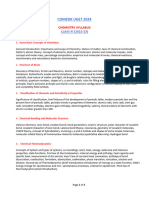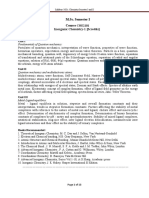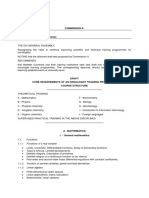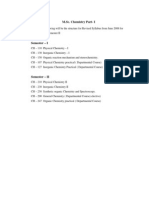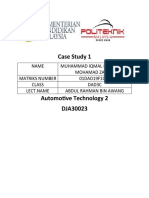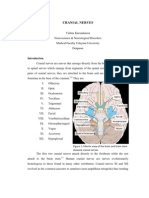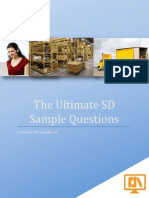0 ratings0% found this document useful (0 votes)
35 viewsRajasthan Public Service Commission, Ajmer
Rajasthan Public Service Commission, Ajmer
Uploaded by
S KThe document outlines the syllabus for the examination for the post of Lecturer (School Education) in Chemistry. It covers 4 parts: (1) senior secondary level chemistry concepts, (2) graduation level chemistry concepts, (3) post graduation level chemistry concepts, and (4) educational psychology, pedagogy, teaching materials, and the use of computers/IT in teaching. The exam will be 3 hours, include 150 multiple choice questions across the 4 subjects, have a maximum score of 300 marks, and use negative marking.
Copyright:
© All Rights Reserved
Available Formats
Download as PDF, TXT or read online from Scribd
Rajasthan Public Service Commission, Ajmer
Rajasthan Public Service Commission, Ajmer
Uploaded by
S K0 ratings0% found this document useful (0 votes)
35 views4 pagesThe document outlines the syllabus for the examination for the post of Lecturer (School Education) in Chemistry. It covers 4 parts: (1) senior secondary level chemistry concepts, (2) graduation level chemistry concepts, (3) post graduation level chemistry concepts, and (4) educational psychology, pedagogy, teaching materials, and the use of computers/IT in teaching. The exam will be 3 hours, include 150 multiple choice questions across the 4 subjects, have a maximum score of 300 marks, and use negative marking.
Original Description:
Rpsc paper 2 syllabus
Original Title
3228BAB9-3ED3-4279-8A05-8165EB6BEB15
Copyright
© © All Rights Reserved
Available Formats
PDF, TXT or read online from Scribd
Share this document
Did you find this document useful?
Is this content inappropriate?
The document outlines the syllabus for the examination for the post of Lecturer (School Education) in Chemistry. It covers 4 parts: (1) senior secondary level chemistry concepts, (2) graduation level chemistry concepts, (3) post graduation level chemistry concepts, and (4) educational psychology, pedagogy, teaching materials, and the use of computers/IT in teaching. The exam will be 3 hours, include 150 multiple choice questions across the 4 subjects, have a maximum score of 300 marks, and use negative marking.
Copyright:
© All Rights Reserved
Available Formats
Download as PDF, TXT or read online from Scribd
Download as pdf or txt
0 ratings0% found this document useful (0 votes)
35 views4 pagesRajasthan Public Service Commission, Ajmer
Rajasthan Public Service Commission, Ajmer
Uploaded by
S KThe document outlines the syllabus for the examination for the post of Lecturer (School Education) in Chemistry. It covers 4 parts: (1) senior secondary level chemistry concepts, (2) graduation level chemistry concepts, (3) post graduation level chemistry concepts, and (4) educational psychology, pedagogy, teaching materials, and the use of computers/IT in teaching. The exam will be 3 hours, include 150 multiple choice questions across the 4 subjects, have a maximum score of 300 marks, and use negative marking.
Copyright:
© All Rights Reserved
Available Formats
Download as PDF, TXT or read online from Scribd
Download as pdf or txt
You are on page 1of 4
RAJASTHAN PUBLIC SERVICE COMMISSION, AJMER
SYLLABUS FOR EXAMINATION FOR THE POST OF
LECTURER (SCHOOL EDUCATION)
CHEMISTRY
PAPER - II
Part – I Senior Secondary Level
1. Atomic Structure:
Fundamental Particles, Modern concept of atomic structure, Quantum numbers,
Aufbau principle, Pauli’s exclusion principle, Hund’s Rules. Electronic
configuration of elements, Classification of elements and periodicity in
properties, s, p, d and f Block elements.
2. p- Block Elements:
General introduction, Electronic configuration, Occurrence, Oxidation states,
Trends in physical and chemical properties.
3. Transition Elements:
Transition elements, Electronic configuration, Oxidation states, Absorption
spectra including charge transfer spectra and magnetic properties, Co-ordination
compounds (Werner’s theory). Nomenclature (IUPAC), Isomerism.
Lanthanides and Actinides: Electronic configuration, Oxidation states, Chemical
reactivity, Lanthanide contraction and its consequences.
4. Solid State & Surface Chemistry:
Classification of solids, Calculation of density of unit cell, Packing in solid, Point
defects, Band theory of metals, Physical and chemical adsorption, Colloids and
emulsions.
5. Solutions:
Types of solutions, Solubility and concentrations, Ideal and non-ideal solutions,
Colligative properties and calculations of molar mass, Abnormal molecular mass,
Vant Hoff factor.
6. Thermodynamics:
Laws of thermodynamics, Zeroth and first law and their applications, Concept of
work and heat, Gibb’s energy.
7. Alkanes, Alkenes, Alkynes and Halo-alkanes:
Methods of preparations and chemical reactions of alkanes, alkenes, alkynes and
haloalkanes.
8. Alcohols, Aldehydes, Ketones, Carboxylic Acids and their derivatives:
Classification, nomenclature, methods of preparation, Chemical reactions of a
alcohols aldehydes, ketones, carboxylic acids and their derivatives.
9. Aromaticity and Arenes:
Aromaticity, Benzene, Alkyl-arenes, Structure of benzene, Electrophilic
substitution reactions, orientation of functional groups.
10. Bio-molecules:
Elementary treatment of carbohydrates, proteins, enzymes, vitamins & nucleic
acids.
Part – II Graduation Level
1. Chemical Bonding:
Theories of chemical bonding, VB and MO theories of Diatomic molecules,
VSEPR theory, Hydrogen bonding, Quantum mechanics, Schrodinger’s wave
equation for one electron system.
2. Co-ordination Complexes:
Details of Crystal field theory for weak and strong field complexes. Comparison
of VB and CFT theories. Factors affecting 10 Dq. Thermodynamic aspects of
Crystal fields, John-Teller effect.
3. Co-ordination Chemistry of Lanthanides and Actinides:
Co-ordination behaviour of Lanthanides and Actinide complexes. Magnetic and
spectroscopic properties.
4. Chemical Dynamics:
Rate of reaction, factors affecting rate of reactions. Zero, first and second order
reactions. Collision and Transition state theories and their comparison.
5. Electrochemistry:
Electrochemical and Galvanic cells, Theory of strong electrolytes. Debye and
Huckel theory of activity coefficient, Nernst equation, Ionic equilibria. Fuel cells,
Corrosion.
6. Enthalpy and Entropy:
Enthalpy and its changes at constant pressure and temperature. Entropy as a
function of temperature and volume. Hess’s Law of constant heat summation,
Gibbs and Helmoltz functions.
7. Conformations and Configuration:
Conformation of alkanes (ethane, butane). R/S nomenclature, Configuration of
alkenes (E/Z) nomenclature. Conformations of cyclo-hexane.
8. Reactions Intermediates:
Free radicals, carbocations, carbanions, cabenes, benzyne, nitrene.
Name Reactions: Nucleophilic Addition reactions and mechanism of Aldol,
Cannizzaro, Perkin, Stobbe, Benzoin, Reformatsky, Knovengel, Baeyer–Villiger,
Wittig and Mannich reactions.
9. Halo, Nitro, Amino-Arenes and Diazonium Salts:
Preparations, Chemical properties of Halo, Nitro, Amino-Arenes and diazonium
salts, elimination and addition mechanism and synthetic applications of
diazonium salts.
10. Polymers and Drugs:
Polymers, Types of polymerization, Natural and synthetic polymers. Drugs
(antacids, anti-histamines, analgesics, antipyretics, antibiotics and antifertility).
Part – III Post Graduation Level
1. Molecular Orbital Theory:
M.O. Theory of polyatomic molecules (AX2, AX3 and AX4).
2. Organometallic Compounds:
Organometallic compounds of Li, Mg, Sn and Fe. Structure, bounding and
applications.
2. Kinetics and Catalysis:
Kinetics of photo-chemical reactions, Acid-Base and Enzyme catalysis.
3. Electrochemistry:
Measurement of E.M.F., Kohlrausch’s Law and its applications, Membrane
equilibria.
4. Thermodynamics:
Third Law of Thermodynamics and Joule-Thompson’s experiment.
5. Substitutions and Elimination Reactions:
SN1, SN2, SNi, E1 and E2 reactions of haloalkanes, Preparation and Chemical
reactions of phenols, ethers and epoxides.
6. Pericyclic Reactions:
Electrocyclic, Cyclo-addition and Sigmatropic rearrangement, Photo-organic
chemistry of alkenes.
7. Environmental Pollution:
Ozone depletion, Green house effect, Global warming.
8. Spectroscopy:
Elementary idea of IR, UV and NMR techniques.
Part – IV (Educational Psychology, Pedagogy, Teaching Learning Material,
Use of Computers and Information Technology in Teaching Learning)
I. Educational Psychology
Concept, scope and functions of educational psychology.
Physical, cognitive, social, emotional and moral developmental
characteristics of adolescent learner and its implication for teaching-
learning.
Behavioural, cognitive and constructivist principles of learning and its
implication for senior secondary students.
Concept of mental health & adjustment and adjustment mechanism.
Emotional intelligence and its implication in teaching learning.
II Pedagogy and Teaching Learning Material (Instructional Strategies for
Adolescent Learner)
Communication skills and its use.
Teaching models- advance organizer, concept attainment, information
processing, inquiry training.
Preparation and use of teaching-learning material during teaching.
Cooperative learning.
III Use of Computers and Information Technology in Teaching Learning
Concept of ICT, hardware and software.
System approach.
Computer assisted learning, computer aided instruction
*****
For the competitive examination for the post of School Lecturer:-
1. The question paper will carry maximum 300 marks.
2. Duration of question paper will be Three Hours.
3. The question paper will carry 150 questions of multiple choices.
4. Negative marking shall be applicable in the evaluation of answers. For every wrong answer one
third of the marks prescribed for that particular question shall be deducted.
5. Paper shall include following subjects :-
(i) Knowledge of Subject Concerned: Senior Secondary Level
(ii) Knowledge of Subject Concerned: Graduation Level.
(iii) Knowledge of Subject Concerned: Post Graduation Level.
(iv) Educational Psychology, Pedagogy, Teaching Learning Material, Use of Computers and
Information Technology in Teaching Learning.
*****
You might also like
- Sentential MeaningDocument7 pagesSentential MeaningEvi SugiartiNo ratings yet
- 3 Chemistry - FinalDocument2 pages3 Chemistry - FinaladeshbhumscNo ratings yet
- Gujarat State Level Eligibility Test: Code No.: 03 Subject: Chemical Sciences Paper Ii and Paper IiiDocument2 pagesGujarat State Level Eligibility Test: Code No.: 03 Subject: Chemical Sciences Paper Ii and Paper IiiDrVaibhav MehtaNo ratings yet
- School of Basic and Applied Sciences: ChemistryDocument2 pagesSchool of Basic and Applied Sciences: ChemistrybhuvneshNo ratings yet
- Chemical Science - SET SyllabusDocument7 pagesChemical Science - SET SyllabusganeshNo ratings yet
- Page 1 of 40Document61 pagesPage 1 of 40Garima KapoorNo ratings yet
- CMG 100 New SyllabusDocument3 pagesCMG 100 New SyllabusSakib NehalNo ratings yet
- School of SciencesDocument13 pagesSchool of SciencescoolpariNo ratings yet
- Contact Hours Per Week: 4 Credits: 4 Terminal Examination Duration: 3 Hours Maximum Marks: 100 (Terminal 80, Sessional 20)Document9 pagesContact Hours Per Week: 4 Credits: 4 Terminal Examination Duration: 3 Hours Maximum Marks: 100 (Terminal 80, Sessional 20)Udoi Sankar MudoiNo ratings yet
- M ScChemistryDocument2 pagesM ScChemistrymarathe_ravindra80% (1)
- General Information Regarding PHDDocument9 pagesGeneral Information Regarding PHDraman123456No ratings yet
- Highschool ChemistryDocument9 pagesHighschool Chemistrystarskyhutch0000No ratings yet
- 17 - Biochemestry 1st YearDocument15 pages17 - Biochemestry 1st YeartaniasumaiyaislamNo ratings yet
- ChemistryDocument34 pagesChemistryrishank guptasNo ratings yet
- 2023-24 M.sc. I Chemical Sciences (University School) NEP-2020Document35 pages2023-24 M.sc. I Chemical Sciences (University School) NEP-2020chaudharirushikesh550No ratings yet
- Chemistry Syllabus 2024Document4 pagesChemistry Syllabus 2024C1B-33-AdityaNo ratings yet
- CSIR - UGC NET Chemical Sciences (CH) SyllabusDocument3 pagesCSIR - UGC NET Chemical Sciences (CH) SyllabusasmiNo ratings yet
- Position: Officer-Quality Control Test Structure: Verbal Ability Quantitative Aptitude Intellectual Potential TestDocument4 pagesPosition: Officer-Quality Control Test Structure: Verbal Ability Quantitative Aptitude Intellectual Potential TestBijan MondalNo ratings yet
- Tamil Nadu Goverment PG Chemistry SyllabusDocument7 pagesTamil Nadu Goverment PG Chemistry SyllabusjayakumarNo ratings yet
- CHEMISTRY EntranceDocument4 pagesCHEMISTRY EntranceHazeNo ratings yet
- chem-syllabusDocument6 pageschem-syllabusAAISHKA TAYADENo ratings yet
- SET Syllabus Chemical Sciences: Inorganic ChemistryDocument3 pagesSET Syllabus Chemical Sciences: Inorganic Chemistryराहुल शर्माNo ratings yet
- Admission Criteria For M.Sc. (Chemistry) CourseDocument2 pagesAdmission Criteria For M.Sc. (Chemistry) CourseAnonymous ZfFzu46j1No ratings yet
- BscsyllDocument15 pagesBscsylldhruv mittalNo ratings yet
- M - Sc. - Chemistry 3rd Sem OrganometallicDocument78 pagesM - Sc. - Chemistry 3rd Sem OrganometallicKhushbooNo ratings yet
- 15321581482018-19 M.sc. Organic Chemistry Part-IIDocument17 pages15321581482018-19 M.sc. Organic Chemistry Part-IIArnab ChakrabortyNo ratings yet
- Chemistry Minor Syllebus FullDocument27 pagesChemistry Minor Syllebus Fullsanzidakhushi1No ratings yet
- 1592456510Ni Ma Vi. Science_3-3 - Rev 1Document5 pages1592456510Ni Ma Vi. Science_3-3 - Rev 1सम्पदा बुढाNo ratings yet
- Gujarat State Eligibility Test: Subject: Chemical Sciences Code No.: 03 Gset SyllabusDocument3 pagesGujarat State Eligibility Test: Subject: Chemical Sciences Code No.: 03 Gset Syllabuschirag sabhayaNo ratings yet
- Chemical SciencesDocument3 pagesChemical SciencesBendi RamarajuNo ratings yet
- StorageDocument12 pagesStorage6623abhishekNo ratings yet
- MScSem1 2 ChemistrySyllabusDocument13 pagesMScSem1 2 ChemistrySyllabusYuv RajNo ratings yet
- Chemistry 3rd Year SyllabusDocument11 pagesChemistry 3rd Year SyllabusPravesh NiraulaNo ratings yet
- PHD Entrance SyllabusDocument4 pagesPHD Entrance SyllabusGuru P MNo ratings yet
- SS ScienceDocument6 pagesSS SciencedBC M8No ratings yet
- Hsa Physical - ScienceDocument4 pagesHsa Physical - Scienceidrees mohammedNo ratings yet
- Commission Ii: Resolution: Oeno 2/91 Oenologist Training ProgrammesDocument19 pagesCommission Ii: Resolution: Oeno 2/91 Oenologist Training ProgrammesJesúsNo ratings yet
- Csir Net Chemistry SylabusDocument3 pagesCsir Net Chemistry SylabuspikumarNo ratings yet
- Syllabus For Master of Science in Organic Chemistry Part-Ii (Semester III and IV)Document14 pagesSyllabus For Master of Science in Organic Chemistry Part-Ii (Semester III and IV)Bhushan ChaudhariNo ratings yet
- M.Sc. I Yr. Chemistry PDFDocument26 pagesM.Sc. I Yr. Chemistry PDFDeepakNo ratings yet
- Pre PHD Course Work Syllabus 170921Document68 pagesPre PHD Course Work Syllabus 170921Vigho AbuNo ratings yet
- IMAT SyllabusDocument6 pagesIMAT SyllabuschathalloornoushadNo ratings yet
- Part-I: UNIT 1 (Organic Chemistry)Document8 pagesPart-I: UNIT 1 (Organic Chemistry)shiva kumarNo ratings yet
- PHD BrochureDocument8 pagesPHD BrochurePrabhakar ChowdaryNo ratings yet
- MSC Syllabus PDFDocument34 pagesMSC Syllabus PDFMayadarNo ratings yet
- Jee-Main Extra Syllabus For Exam Junior & Senior - Total - Topics-2Document3 pagesJee-Main Extra Syllabus For Exam Junior & Senior - Total - Topics-2Hemanth MindhiNo ratings yet
- CHE101 Course Outline Spring 2024 727818477Document2 pagesCHE101 Course Outline Spring 2024 727818477jkpsw9j7p4No ratings yet
- Course Work ChemistryDocument4 pagesCourse Work ChemistryAamerNo ratings yet
- XL - P Chemistry (Compulsory For All XL Candidates)Document2 pagesXL - P Chemistry (Compulsory For All XL Candidates)Shivam RaiNo ratings yet
- 1.stoichiometry: Calculations Involving Equilibrium ConstansDocument2 pages1.stoichiometry: Calculations Involving Equilibrium ConstanslayanNo ratings yet
- Sy 120720014753Document9 pagesSy 120720014753npradeepji100% (1)
- Department of Chemistry Presidency University Ph.D. Course Work SyllabusDocument7 pagesDepartment of Chemistry Presidency University Ph.D. Course Work SyllabusSubhro ChatterjeeNo ratings yet
- Syllabus For PIEAS TestDocument4 pagesSyllabus For PIEAS Testmazherchemist401No ratings yet
- XL-P (Compulsory For All XL Candidates) ChemistryDocument1 pageXL-P (Compulsory For All XL Candidates) ChemistrysayantoNo ratings yet
- Chem AwDocument173 pagesChem AwAnanya RathoreNo ratings yet
- Reduced B.sc. IV & VI Sem (Non NEP) Syllabus 2024Document6 pagesReduced B.sc. IV & VI Sem (Non NEP) Syllabus 2024Neeraj Singh BishtNo ratings yet
- Chemical Science SET Syllabus-1Document4 pagesChemical Science SET Syllabus-1Gayatri HalliNo ratings yet
- 7th Sem SyllabusDocument6 pages7th Sem SyllabusDebopam RayNo ratings yet
- U.P. Higher Education Services Commission, Allahabd ChemistryDocument4 pagesU.P. Higher Education Services Commission, Allahabd ChemistryAnupam AwasthiNo ratings yet
- Mastering Chemistry: A Comprehensive Guide to ExcellenceFrom EverandMastering Chemistry: A Comprehensive Guide to ExcellenceRating: 3 out of 5 stars3/5 (1)
- MSC Chemistry SchemeDocument2 pagesMSC Chemistry SchemeS KNo ratings yet
- SchemeSyllabi MScChemistry 2021-23Document87 pagesSchemeSyllabi MScChemistry 2021-23S KNo ratings yet
- Academic Calendar (July-December 2022) 83830Document1 pageAcademic Calendar (July-December 2022) 83830S KNo ratings yet
- Department of Chemistry MSC 2year COPO Long MapDocument48 pagesDepartment of Chemistry MSC 2year COPO Long MapS KNo ratings yet
- Case Study 1Document7 pagesCase Study 1Muhammad Atif100% (1)
- 6THPTimingDocument13 pages6THPTimingpeterkevinlegendNo ratings yet
- Say Again ResumenDocument24 pagesSay Again ResumenDylan CarrascoNo ratings yet
- PowermateysarrrghDocument32 pagesPowermateysarrrghBrianHazeNo ratings yet
- D PDFDocument38 pagesD PDFvictor figueroaNo ratings yet
- Egorov ArtemDocument38 pagesEgorov ArtemAndrei MartinasNo ratings yet
- Zinamp: TH THDocument26 pagesZinamp: TH THR HastomoNo ratings yet
- Figure 1: Inferior View of The Brain and Brain Stem Showing Cranial NervesDocument40 pagesFigure 1: Inferior View of The Brain and Brain Stem Showing Cranial NervesVishnu Karunakaran0% (1)
- Office of The Principal, Government Polytecnic College, Harda (M.P.) 461-331Document1 pageOffice of The Principal, Government Polytecnic College, Harda (M.P.) 461-331Shubham AgrawalNo ratings yet
- Jha 2018Document4 pagesJha 2018AditiNo ratings yet
- OS Heisman Sliders - Zero ThreshDocument7 pagesOS Heisman Sliders - Zero ThreshBenjamin Martinez0% (1)
- Annexure 21 PDFDocument17 pagesAnnexure 21 PDFchinky_movieNo ratings yet
- Sustainable Futures: Veronika Agustini Srimulyani, Sri Rustiyaningsih, Florentina Anif Farida, Yustinus Budi HermantoDocument14 pagesSustainable Futures: Veronika Agustini Srimulyani, Sri Rustiyaningsih, Florentina Anif Farida, Yustinus Budi HermantoHaru FirdausNo ratings yet
- W5-Trompenaars & Hampden-Turner Cultural DimensionsDocument2 pagesW5-Trompenaars & Hampden-Turner Cultural DimensionsafiqahNo ratings yet
- Pigeonhole Principle FinalDocument73 pagesPigeonhole Principle FinalVicky Feliciano100% (3)
- Umashanker Sir Mum NoidaDocument17 pagesUmashanker Sir Mum Noidadasleo546No ratings yet
- Report of Stock VerificationDocument3 pagesReport of Stock VerificationAJAY VASANTH X (1692)No ratings yet
- DEF Value Chain AnalysisDocument5 pagesDEF Value Chain AnalysisMusa LarbiroNo ratings yet
- Assignment 1 PROGRAMMING FOR MOBILE DEVICES (CCS21503)Document11 pagesAssignment 1 PROGRAMMING FOR MOBILE DEVICES (CCS21503)Syahidah Binti Mohamed AliNo ratings yet
- Aakash ZoologyDocument18 pagesAakash ZoologyYUGESH SINGARAM0% (1)
- SDSampleQuestionsv3 04Document18 pagesSDSampleQuestionsv3 04Deepak SangramsinghNo ratings yet
- JGJ102-2003 - English Version (Verified) PDFDocument63 pagesJGJ102-2003 - English Version (Verified) PDFChien ChieuNo ratings yet
- Full download Quantum Phase Transitions 2nd Edition Subir Sachdev pdf docxDocument81 pagesFull download Quantum Phase Transitions 2nd Edition Subir Sachdev pdf docxtrikiparlNo ratings yet
- Numeric Display Mobile Radios: MOTOTRBO™ System Components and BenefitsDocument2 pagesNumeric Display Mobile Radios: MOTOTRBO™ System Components and BenefitsLaraNo ratings yet
- SIRE - Tablet-Based InspectionsDocument5 pagesSIRE - Tablet-Based InspectionsLaiqNo ratings yet
- 5MBDocument107 pages5MBPascar Ioan100% (1)
- 2CDS200936R0001 s2c h11l Auxiliary ContactDocument2 pages2CDS200936R0001 s2c h11l Auxiliary ContactJhonny Velasquez PerezNo ratings yet
- Surgery EntranceDocument352 pagesSurgery EntranceDipesh Shrestha100% (1)
- Gisela Nursery and Primary Schools: Holiday Package No. 2 - May, 2020 ART GRADE TWODocument25 pagesGisela Nursery and Primary Schools: Holiday Package No. 2 - May, 2020 ART GRADE TWOTrump DonaldNo ratings yet















